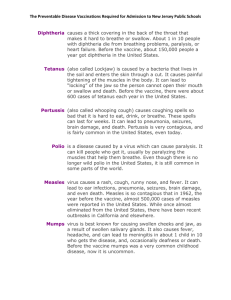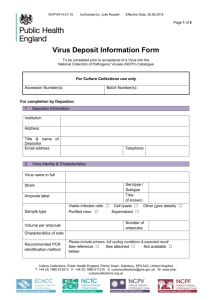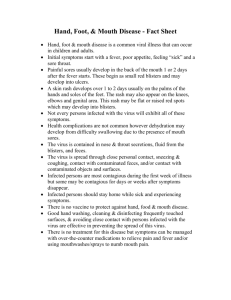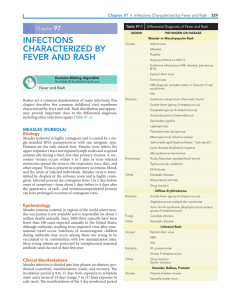File - AnGela Preston
advertisement
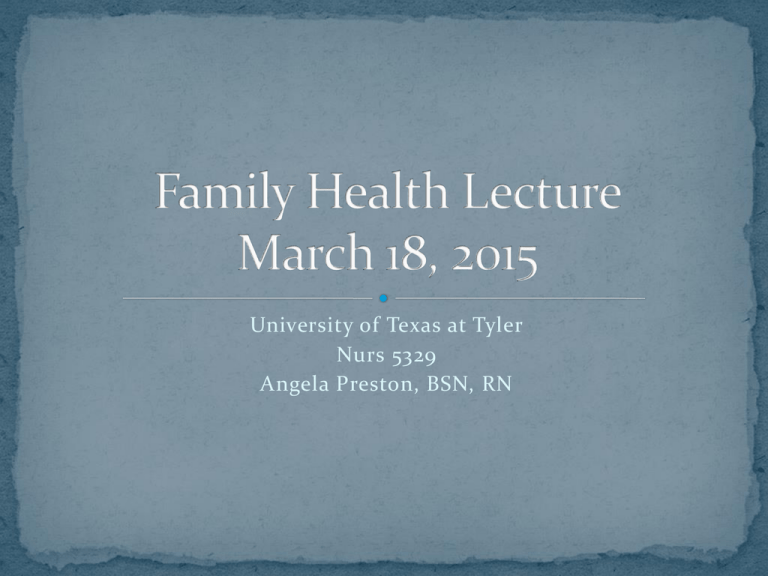
University of Texas at Tyler Nurs 5329 Angela Preston, BSN, RN “Children are the hands by which we take hold of heaven” -Henry Beecher Chapter 22 COMMUNICABLE DISEASES Expected Learning Outcomes: Identify common communicable diseases, collaborative management and prevention for pediatric population. Use the nursing process to describe the nursing care of a child with an infectious disease. Pre-class Assignments: Pediatric Chapter 22 pp. 497-518. Hepatitis B Measles, mumps, Diphtheria*, tetanus*, pertussis-DTaP Polio- IPV* Haemophilus influenzae Type B –Hib* Pneumococcal- PCV* Rotavirus- RV* rubella- MMR Varicella- V Hepatitis A Influenza- FLU Meningococcal* Human Papilloma Virus- HPV* Private Insurance or State Funded Educate on possible side effects- including mild fever/cold symptoms or soreness/redness at injection site Teach appropriate doses of acetaminophen or ibuprofen for relief Provide Vaccine Information Statement (VIS) and obtain parental consent Document lot #, site, manufacturer Report all adverse effects of immunizations Location of administration Active immunity Natural active immunity Vaccine-induced immunity Passive immunity Natural passive immunity Passive immunity through immunoglobulins What is an example of each type?? Inactivated or killed organism Live attenuated or weakened virus- can cause mild symptoms Acellular vaccine Toxoids Subunit of virus Exposure to the disease Incubation period of the disease and the onset of symptoms Communicable diseases in the past Child’s immunization history Physical assessment, including prodromal and general signs and symptoms Universal precautions: Prevent the transmission of bloodborne pathogens; provide guidelines for using protective barriers Standard precautions: more comprehensive, applying to patients in all settings Isolation guidelines: contact, droplet, and airborne precautions Difficulty breathing Behavior changes: Blue, gray, or purple lethargy, acting withdrawn, unresponsiveness Seizure activity Purple or red rash Dehydration tinge to lips or skin Fever with headache or stiff neck Vomiting blood, or blood in stool Erythema Infectiosum (Fifth’s Disease) Mononucleosis Mumps (Parotitis) Hand-Foot-and-Mouth Disease Rubella (German measles) Respiratory Syncytial Virus Rubeola (Measles) Bronchiolitis Roseola (Exanthum subitum) HHV 6 Hepatitis A Hepatitis B Influenza Varicella zoster (Chickenpox) Bordetella pertussis (Whooping cough) Group A Strep throat/Scarlet fever Conjunctivitis (Pink eye) Include: 1. Incidence in US & globally Distribution of Content for the NCLEX-RN® Test Plan Physiological Adaptation 14% Reduction of Risk Potential 12% Pharmacological and Parenteral Therapies 15% Safety and Infection Control 12% Health Promotion and Maintenance 9% Basic Care and Comfort 9% Psychosocial Integrity 9% Management of Care 20% 2. If it is a vaccine-preventable disease; if so, what age vaccine is given along with information r/t vaccine 3. Physiological effect- how does virus or bacteria manifest itself in the body (include incubation period, prodromal phase and communicability) 4. Nursing management including: • Assessment- expected signs and symptoms • Comfort • Treatment &/or medication- how disease is usually diagnosed, i.e. lab tests, is it viral or bacterial? • Education 5. Special considerations/Higher risk population/Emergent care www.ncsbn.org https://www.dshs.state.tx.us www.cdc.gov Textbook Powerpoint posted online for Mod 9 Communicable Diseases www.mayoclinic.org www.healthychildren.org 1. Gather information and answer questions 2. Present information to class through skit, short powerpoint, Take notes on other groups Human parvovirus B19 Transmission by contact with respiratory secretions 4- to 21-day incubation period Contagious until rash appears “Slapped cheek” appearance Agent: Coxsackie virus or enterovirus Transmitted by direct contact, respiratory, fecal-oral route 3- to 6-day incubation period May be shed for several weeks Small vesicles in mouth and on hands and feet Respiratory Syncytial Virus Bronchiolitis Agent: respiratory syncytial virus Transmitted by contact with saliva and nasal secretions; can live on surfaces for several hours; readily transmitted by hands 4- to 6-day incubation period Viral shedding may last 6 weeks Premature babies high risk of hospitalization if acquire RSV Roseola (Exanthum Subitum), HHV-6 Agent: human herpes virus 6 Transmitted by saliva of persons who have the disease or are carrying the virus 9- to 10-day incubation period Communicability is unknown Pink or red papular rash appears on the day the fever returns to normal Hepatitis A Hepatitis B Agent: hepatitis A virus Agent: hepatitis B virus Transmitted by blood or Transmitted by contaminated food, fecaloral route Incubation period approximately 30 days Most contagious for 2 weeks before onset of symptoms and for 1 week after onset of jaundice blood products, sexual contact Incubation period on average is 90 days Can be spread as long as the virus is in the blood of an individual; some people are chronic carriers and carry the disease for life *What is given to newborns whose mothers are HbsAg+?* Influenza Agent: influenza viruses Type A (H1N1), Type A (H3N2), or Type B Transmitted by contact with contaminated objects, coughing and sneezing 1- to 4-day incubation period Can be spread 1 day before until 7 days after symptoms Mononucleosis Agent: Epstein-Barr virus Transmitted by person-to- person contact, sharing of personal objects 30- to 50-day incubation period Virus may be excreted for months following infection May develop splenomegaly or hepatomegaly Scenario 12 month old infant in good health up to date on vaccinations presents to clinic with sudden onset of moderate fever (103 degrees) lasting for four days with otherwise non-specific complaints. Mother calls clinic because fever has returned to normal, but mild, pink, papules 1-5mm in diameter have appeared all over body. What is an appropriate nursing diagnosis? Viral Diseases — (6) Mumps or Parotitis Agent: paramyxovirus Transmitted by contact with oral and nasal secretions 16- to 18-day incubation period Can be spread 2 to 3 days before swelling of salivary glands up to 5 days after swelling starts Rubella (German Measles) Agent: rubella virus Airborne through respiratory droplets or direct contact with secretions; also found in blood, urine, and stool 16- to 18-day incubation period Can be spread from 7 days before until 14 days after rash; starts at hairline and works down Rubeola (Measles) Agent: measles virus Airborne through respiratory droplets or direct contact with secretions 8- to 12-day incubation period Can be spread 1 to 2 days before prodromal symptoms, 3 to 5 days before rash, and 4 days after rash appears Presence of Koplik spots in the mouth Viral Diseases — (8) VaricellaZoster (Chicken Pox) Agent: Varicella zoster virus Transmitted by fluid from vesicles, secretions from nose, mouth and eyes, and airborne from coughing and sneezing 10- to 21-day incubation period Can be spread 1 day before rash appears until all vesicles have crusted over Same virus causes Shingles(Herpes Zoster virus) later in life A mother comes into the clinic concerned because her 6- year old daughter was just diagnosed with varicella zoster. The blisters have begun to scab over. There is a 3 year old and another 4 month old infant in the home. What does the nurse recommend regarding prevention of the disease? Agent: Bordetella pertussis Transmitted through oral and nasal secretions 6- to 21-day incubation period Contagious from the onset of symptoms and for about 2 weeks; infants not immunized may be contagious for at least 6 weeks DTaP- 2 month shots Cough ends with crowing (whooping), coughing “fits” Agent: Group A beta-hemolytic streptococcus Transmitted by respiratory droplets, direct contact with secretions 2- to 5-day incubation period Can be spread for 10 days without treatment; not contagious after 24 hours on antibiotics Scarlet fever is strep throat with a rash in “creases of body”, possibly strawberry-like tongue Swollen tonsils, may or may not have white pus pockets, may be associated with stomach ache Agent: virus (adenovirus-cold) or bacteria Transmitted through contact with discharge from an infected eye, either directly or by touching contaminated surfaces Communicability varies depending on the organism Bacterial- classic pink eye, pink/red, swelling, purulent discharge, eyes “crusted” shut in AM, abx begin resolving in 24 hours Viral- pink, excessive tearing, may be slight crusting from tears, eyes might feel “dry”, no treatment available Both contagious- educate to change pillows nightly, not to share hand towels, meticulous hand washing, do not touch eyes, requires doctor appointment to diagnose and prescribe antibiotic eye drops (if bacterial), warm compress may help alleviate pain May cause re-infection if not cared for carefully, easily spread to both eyes and among family members, schools. Upon presentation to clinic, ask history A mother is caring for her 9-month-old baby, who has respiratory a. b. c. d. syncytial virus, and is calling the pediatrician’s office for advice. She reports that the baby is fussy and doesn’t want to take her bottle. She just noticed she has only changed one wet diaper that day and when the baby cries she’s not seeing tears. Which of the following would be the appropriate recommendation by the nurse? “The baby will need to be seen by the doctor today. Let’s get you set up for an appointment .” “Suction the nose prior to feedings and provide them more frequently in small amounts. Offer pain relief as needed.” “The baby is in respiratory distress and needs to be taken to the emergency room immediately.” “Administer over-the-counter cough/cold medicine to help alleviate the symptoms.” The nurse knows the child is at risk for dehydration when the mother says she has had a notable decrease in wet diapers in 24 hours and is crying without tears. By suctioning prior to feedings, making them frequent and small, and comforting the infant through holding or giving pain relief if needed, the mother will be setting her child up for a successful feed. The nurse can recommend a visit to the pediatrician or ER if this does not increase diapers following this regime within a 12 hour period or if the child begins projectile vomiting or becomes lethargic. A 4-year-old boy is brought into the pediatrician’s office for a. b. c. d. evaluation of fever, headache, and new-onset rash noted in his armpits and groin and behind his knees. The nurse assesses the boy’s mouth and throat and notices his tongue has a strawberry-like appearance. She inquires if the boy has been exposed to any sick children. The mother replies that several children in his daycare have had a sore throat. The nurse suspects which of the following communicable diseases? Exanthem subitum Hand-Foot-and-Mouth Scarlet fever Erythema infectiosum a. Scarlet fever Scarlet fever is strep throat with a rash. A fine, red rash with the texture of sandpaper is more pronounced in the armpits and groin, in the creases of the elbows, and behind the knees. A strawberry tongue may also be noted. The child may also complain of stomach pain. Minute Paper & Muddy Points: You may use bullets. 1. Starting now- write down in bullets what you learned today, starting with the most important and working down to less important points. 2. What was “muddy” or unclear that you want to know more about? Include your name because I will go review these and send out an email to clarify significant questions.
